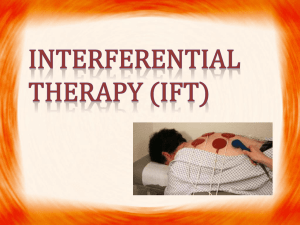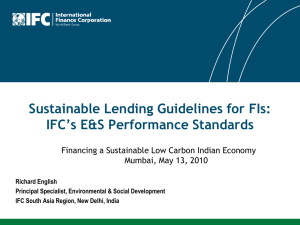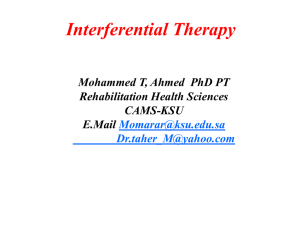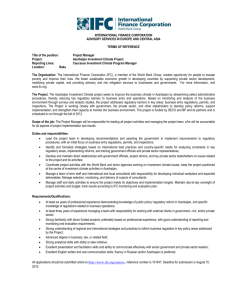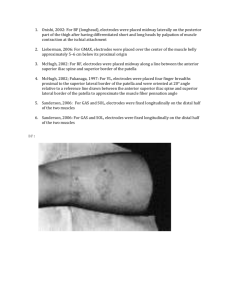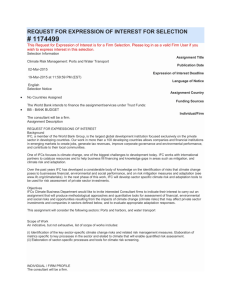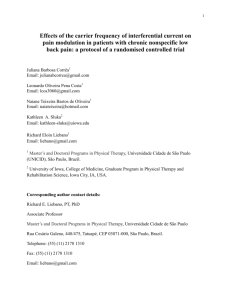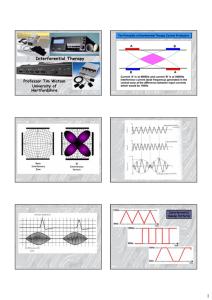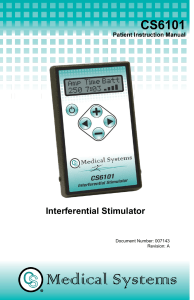Interferential Current (IFC)
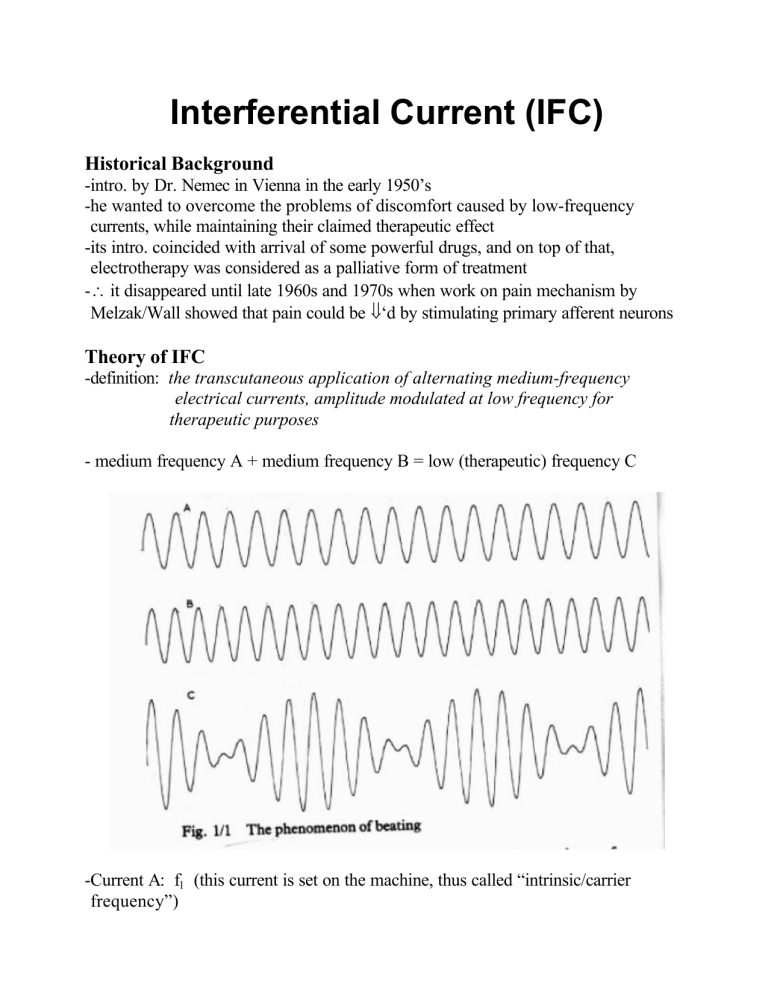
Interferential Current (IFC)
Historical Background
-intro. by Dr. Nemec in Vienna in the early 1950’s
-he wanted to overcome the problems of discomfort caused by low-frequency currents, while maintaining their claimed therapeutic effect
-its intro. coincided with arrival of some powerful drugs, and on top of that, electrotherapy was considered as a palliative form of treatment
-
∴
it disappeared until late 1960s and 1970s when work on pain mechanism by
Melzak/Wall showed that pain could be
⇓
‘d by stimulating primary afferent neurons
Theory of IFC
-definition: the transcutaneous application of alternating medium-frequency electrical currents, amplitude modulated at low frequency for therapeutic purposes
- medium frequency A + medium frequency B = low (therapeutic) frequency C
-Current A: f
1
(this current is set on the machine, thus called “intrinsic/carrier frequency”)
-Current B: f
2
(same amplitude, but slightly higher frequency; therapist sets this one)
-as you can see, current B falls alternately into and out of step with current A
(
∴
alternately reinforcing it at some points, and weakening it at others!)
-resultant waveform: sinusoidal, with frequency F
-
∴
F = f
2
- f
1
-as can be seen, the amplitude of F (Current C) is NOT constant
-this we call a beat frequency è current C, a sine wave of frequency F, is said to be amplitude modulated by f
2
- f
1
But why use 2 medium frequency currents???
-medium frequency currents è associated with a lower skin resistance (impedance), thus more comfortable than low frequency currents
-
∴
using a medium frequency, a more tolerable penetration of current through the
skin is possible
Practical Applications of IFC
-in the clinic, f
1
is fixed on the machine, usually @ 4 000 Hz (2 000Hz and 6000Hz
also available)
-f
2
would be variable from 4 001 Hz to 4 150 Hz (why is it better to have f2 “ swin g” within a range of frequencies? Limits accommodation and habituation to current)
-
∴
F = f
2
- f
1
ranges from 1 Hz to 150 Hz (the frequency swing is also referred to as spectrum or sweep )
-traditional method of applying IFC è 4 electrodes supplied by two channels fig. 2 insert fig. 3 insert
-some machines have a balance control è to allow the output of one channel to be
increased while decreasing the other
-bipolar (premodulated) mode è can use only two electrodes because the two
medium frequency currents are added inside the
machine to produce the low freq. output!
-disadv. of bipolar mode: there is more sensory stimulation, since the low freq. current is already produced by the machine, and has to go through the skin è unpleasant
Physiological Effects of IFC
1) Relief of Pain
-important because pain produces spasm, unnatural movement, and production of more strain.
-set F at 80-100Hz è analgesic effect with a vasodilatory effect on the tissues.
*IFC is not effective in post-traumatic pain in the acute stages!! It is effective in cases of chronic pain with or without swelling.
2) Reduction of Swelling
-important because organization of the exudate leads to the formation of adhesions and impairment of function
-set F at 1-30Hz è causes electroporation (increased permeability of the cell
membrane, which helps ion movement to and from cells)
è causes
⇑
in venous and lymphatic flow, and
⇑
tone of tissues
and vessels which aid in the relief of edema
-progress Rx by setting F at 1-10Hz è causes vasodilation, and has a vigorous
pumping effect which will
⇑
the physiologic
mechanisms for the absorption of the
exudate.
**Indirectly, IFC promotes healing and helps in the restoration of function!**
Types of Electrodes
1) Plate Electrodes
-plates made of conducting rubber which are comfortable and long lasting
-larger plates give more comfortable treatment and deeper effect
-smaller plates are used for a localized effect, but this effect is more superficial
-plates are attached to the patient by means of straps or bandages
-be sure to have good contact of the plate with the patient è allows for more pleasant treatment and greater tolerance of current
Covering: -the electrodes must be fully covered with absorbent material
-Spontex has been found to be very effective
-coverings should be soaked in water or a solution of bicarbonate of soda to
⇑
conduction and allow a more comfortable contact with skin
-the coverings must be kept clean and washed thoroughly and dried after use
2) Vacuum Electrodes
-the IFC unit is plugged into a vacuum unit è a rubber suction cup connected to a
machine capable of producing a vacuum
-they’re really plate electrodes kept in position by a vacuum instead of bandaging
-around the neck of the cup is a rubber collar covering a small hole
-by lifting the collar, air is let into the cup, thus allowing the electrode to be moved while the vacuum is in operation
-do not try and tug off the electrode from the patient without releasing the vacuum è discomfort and bruising may result!
-place wet sponges in the cups and moisten the edges of the cups for better adherence
-the suction should not be constant è uncomfortable and causes bruising
-it may be pulsed and adjusted to increase and decrease at a desired speed
-vacuum electrodes are excellent for treating flat smooth areas è e.g. back or a plump
knee
-not ideal for hairy areas è can’t get an airtight seal fig. 4 insert
3) Combined Electrodes
-all four contacts are embedded in some insulating material and can be applied as one pad
-there are different sizes (small, medium and large) for different surfaces to be treated
-limited by the low intensity of current that can be tolerated è
∴
general effect is
small
-if possible, use larger separate plate electrodes!!
QuickTime™ and a
None decompressor are needed to see this picture.
Intensity of Treatment
-use an intensity of current which produces a strong but comfortable prickling without a muscular contraction
-steps to follow: 1)
⇑
current until the patient feels a definite prickling, and leave for one minute for it to decrease
2)
⇑
current again until the patient reports a slight muscular contraction, then decrease until contraction stops
-may teach the patient to increase intensity periodically in order to obtain longer lasting pain relief
Duration of Treatment
-IFC usually applied for 10-15 minutes
-treatment at a normal intensity should not be given to one area for longer than 20 minutes
-if more than one area is to be treated è total time should not exceed 30 min.
**too long a Rx makes pt. unacceptably tired later in the day!**
Frequency of Treatment
-in most cases, treatment every other day (i.e. 3x/wk.) is ideal
-treatment less than twice/week is usually a waste of time
-a course of 12 treatments is given
Electrode Placement:
-painful area (86.4%)
-spinal nerve root (53%)
-peripheral nerve (26%)
-trigger point (10%)
-acupuncture point (5%)
*Percentages denote responses of therapist when asked about IFC electrode placement for cases of low back pain.
Before applying IFC, ask yourself the following:
1) What do I hope to achieve?
2) How can this be done?
3) What frequency would be most effective?
4) Should 2 or 4 electrodes be used?
5) Where exactly are the electrodes to be placed?
6) How long a treatment should be given?
Contraindications
1)Arterial disease
-the stimulatory effect of the current could produce emboli
2) Deep Vein Thrombosis
-in the acute phase, it is possible to dislodge the thrombi or increase the inflammation of the phlebitis
3) Infective conditions
-could spread the infection or exacerbate due to the stimulatory effects of the current
4) Pregnant Uterus
-not safe for fetus
-may however use for S.I. joint strain during pregnancy if IFC placed superficially over S.I. ligaments
5) Danger of haemorrhage
-stimulating effect can cause an
⇑
in bleeding
6) Malignant tumors
-direct stimulation of tumor is CI, but reffered pain from cancer or metastasis can be treated
7) Artificial pacemakers
-a demand unit must sense the electrical activity of the heart, thus avoid an electric device that may interfere with it
8) Large open wounds
-these will cause concentration of the current and distortion of the IF field
9) Dermatological conditions
-IFC may exacerbate any dermatological condition in the area being treated
Current Research
1) Minder et al.
Interferential therapy: lack of effect upon experimentally induced delayed onset muscle soreness
Clin Physiol & Func Im (2002) 339-347
2) Johnson et al.
A single-blind placebo-controlled investigation into the analgesic effects of interferential currents on experimentally induced ishaemic pain in healthy subjects
Clin Physiol & Func Im (2002) 187-196
3) Hurley et al.
Interferential therapy electrode placement technique in acute low back pain: a preliminary investigation
Arch Phys Med Rehabil (2001) 82,485-93
4) Watson, T
The role of electrotherapy in contemporary physiotherapy practice
Manual Therapy (2000) 5(3), 132-141
5) Johnson et al.
A double blind placebo controlled investigation into the analgesic effects of interferential current (IFC) and transcutaneous electrical nerve stimulation (TENS) on cold-induced pain in healthy subjects
Physiotherapy Theory and Practice (1999) 15, 217-233
6) Olson et al.
The effects of TENS and Interferential Current on cutaneous blood flow in healthy subjects
Physiotherapy Canada (1999) 51 (1), 27-31
7) Fourie et al.
Stimulation of bone healing in new fractures of the tibial shaft using interferential currents
Physiotherapy Research International (1997) 2 (4), 255-268
